The Laver (Outer Court)
Thou shalt also make a laver of brass, and his foot also of brass, to wash withal: and thou shalt put it between the tabernacle of the congregation and the altar, and thou shalt put water therein. Exodus 30:18
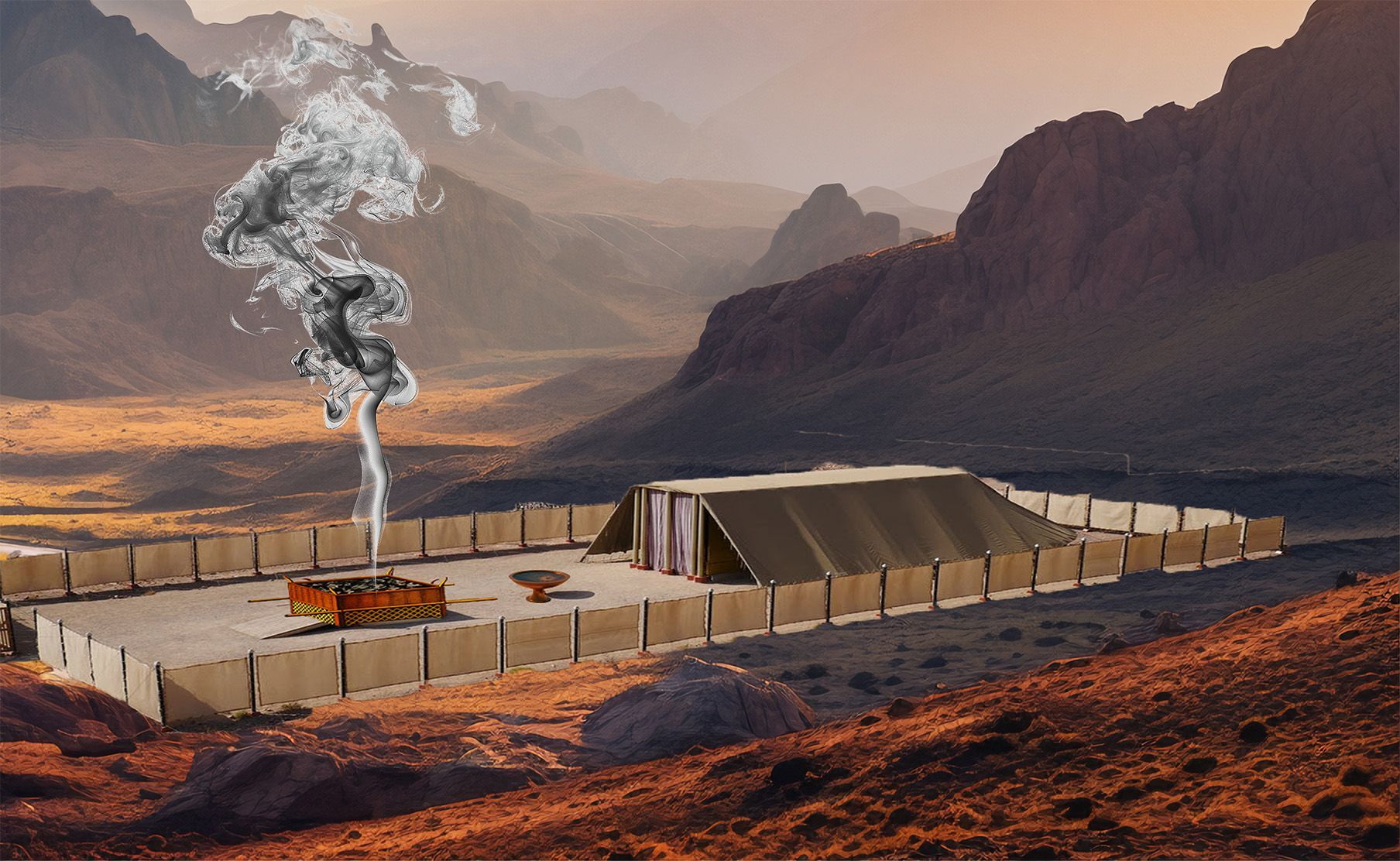

The Israelites had various ceremonies that they were to perform as required by God. Most of these ceremonies revolved around a structure called the sanctuary. In this study, not only will you learn the significance of this structure and the services performed there but you will also see that the sanctuary service still has a profound meaning for us today.
What did God instruct Moses to build?
And let them make me a sanctuary; that I may dwell among them. Exodus 25:8
Why did God instruct Moses to build a Sanctuary?
Regarding the Israelites, Ellen White says, "Accustomed as they had been in Egypt to material representations of the Deity, and these of the most degrading nature, it was difficult for them to conceive of the existence or the character of the Unseen One. In pity for their weakness, God gave them a symbol of His presence." Ed p. 34
From the above excerpt, it appears that God, in His mercy and understanding of His children, wanted to give them a visual representation of Himself through the earthly tabernacle.
What was one of the main functions of the sanctuary?
"And almost all things are by the law purged with blood; and without shedding of blood is no remission." Hebrews 9:22
Refering to the sacrificial offerings of the Old Covenant, we should understand that the sanctuary was the instrument that faciliated the remission of sin. In this manner, the sanctuary was part of God's plan of salvation.
The Sections of the Sanctuary
The Holy and Most Holy Place
"...and the vail shall divide unto you between the holy place and the most holy." Exodus 26:33
According to Scripture, the inner sanctuary had two internal compartments— The Holy Place, and the Most Holy Place.
The Outer Court
The And thou shalt make the court of the tabernacle… Exodus 27:9
The sanctuary was enclosed in an open space called the court of the tabernacle. This court is where the animals were slain.
The Israelites had various ceremonies that they were to perform as required by God. Most of these ceremonies revolved around a structure called the sanctuary. In this study, not only will you learn the significance of this structure and the services performed there but you will also see that the sanctuary service still has a profound meaning for us today.
What did God instruct Moses to build?
And let them make me a sanctuary; that I may dwell among them. Exodus 25:8
Why did God instruct Moses to build a Sanctuary?
Regarding the Israelites, Ellen White says, "Accustomed as they had been in Egypt to material representations of the Deity, and these of the most degrading nature, it was difficult for them to conceive of the existence or the character of the Unseen One. In pity for their weakness, God gave them a symbol of His presence." Ed p. 34
From the above excerpt, it appears that God, in His mercy and understanding of His children, wanted to give them a visual representation of Himself through the earthly tabernacle.
What was one of the main functions of the sanctuary?
"And almost all things are by the law purged with blood; and without shedding of blood is no remission." Hebrews 9:22
Refering to the sacrificial offerings of the Old Covenant, we should understand that the sanctuary was the instrument that faciliated the remission of sin. In this manner, the sanctuary was part of God's plan of salvation.
The Sections of the Sanctuary
The Holy and Most Holy Place
"...and the vail shall divide unto you between the holy place and the most holy." Exodus 26:33
According to Scripture, the inner sanctuary had two internal compartments— The Holy Place, and the Most Holy Place.
The Outer Court
The And thou shalt make the court of the tabernacle… Exodus 27:9.
The sanctuary was enclosed in an open space called the court of the tabernacle. This court is where the animals were slain.
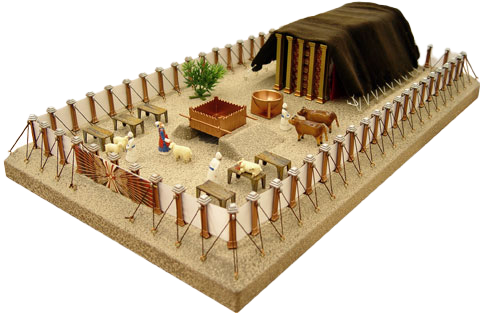
The Israelites had various ceremonies that they were to perform as required by God. Most of these ceremonies revolved around a structure called the sanctuary. In this study, not only will you learn the significance of this structure and the services performed there but you will also see that the sanctuary service still has a profound meaning for us today.
What did God instruct Moses to build?
And let them make me a sanctuary; that I may dwell among them. Exodus 25:8
Why did God instruct Moses to build a Sanctuary?
Regarding the Israelites, Ellen White says, "Accustomed as they had been in Egypt to material representations of the Deity, and these of the most degrading nature, it was difficult for them to conceive of the existence or the character of the Unseen One. In pity for their weakness, God gave them a symbol of His presence." Ed p. 34
From the above excerpt, it appears that God, in His mercy and understanding of His children, wanted to give them a visual representation of Himself through the earthly tabernacle.
What was one of the main functions of the sanctuary?
"And almost all things are by the law purged with blood; and without shedding of blood is no remission." Hebrews 9:22
Refering to the sacrificial offerings of the Old Covenant, we should understand that the sanctuary was the instrument that faciliated the remission of sin. In this manner, the sanctuary was part of God's plan of salvation.
The Sections of the Sanctuary
The Furniture of the sancturay
Two pieces of furniture existed in the court of the tabernacle: The altar of burnt offering and the laver.
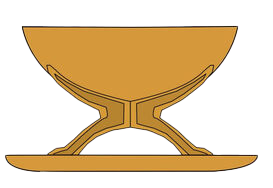
The Laver (Outer Court)
Thou shalt also make a laver of brass, and his foot also of brass, to wash withal: and thou shalt put it between the tabernacle of the congregation and the altar, and thou shalt put water therein. Exodus 30:18
"The laver was placed between the altar and the congregation, that before they came into the presence of God, in the sight of the congregation, they might wash their hands and their feet. What impression was this to make upon the people? It was to show them that every particle of dust must be put away before they could go into the presence of God; for he was so high and holy that unless they did comply with these conditions, death would follow. The Lord requires his ministers to be pure and holy, rightly to represent the principles of truth in their own lives, and by their example to bring others up upon a high level." GW92 162

The Altar of Burnt Offering (Outer Court)
Thou shalt also make a laver of brass, and his foot also of brass, to wash withal: and thou shalt put it between the tabernacle of the congregation and the altar, and thou shalt put water therein. Exodus 30:18
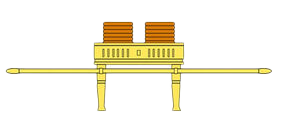
Table of Shewbread (Holy Place)
And thou shalt set upon the table shewbread before me alway. Exodus 25:30
"The showbread was kept ever before the Lord as a perpetual offering. Thus it was a part of the daily sacrifice. It was called showbread, or 'bread of the presence,' because it was ever before the face of the Lord. It was an acknowledgment of man's dependence upon God for both temporal and spiritual food, and that it is received only through the mediation of Christ. God had fed Israel in the wilderness with bread from heaven, and they were still dependent upon His bounty, both for temporal food and spiritual blessings. Both the manna and the showbread pointed to Christ, the living Bread, who is ever in the presence of God for us. He Himself said, 'I am the living Bread which came down from heaven.' John 6:48-51. Frankincense was placed upon the loaves. When the bread was removed every Sabbath, to be replaced by fresh loaves, the frankincense was burned upon the altar as a memorial before God." PP 354
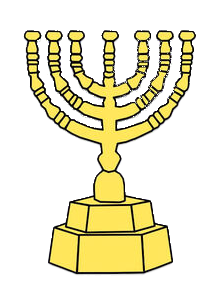
Golden Candlestick (Holy Place)
And thou shalt make a candlestick of pure gold: of beaten work shall the candlestick be made: his shaft, and his branches, his bowls, his knops, and his flowers, shall be of the same. And six branches shall come out of the sides of it; three branches of the candlestick out of the one side, and three branches of the candlestick out of the other side. Exodus 25:31-32
"These sacred apartments had no windows to give light. The candlestick was made of purest gold, and was kept burning night and day, and gave light to both apartments. The light of the lamps upon the candlestick reflected upon the boards plated with gold, at the sides of the building, and upon the sacred furniture, and upon the curtains of beautiful colors with cherubims wrought with threads of gold and silver, which appearance was glorious beyond description." 4aSG 9
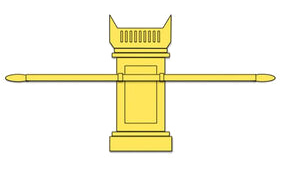
Altar of Incense (Holy Place)
And thou shalt make an altar to burn incense upon: of shittim wood shalt thou make it. Exodus 30:1
And Aaron shall burn thereon sweet incense every morning: when he dresseth the lamps, he shall burn incense upon it. And when Aaron lighteth the lamps at even, he shall burn incense upon it, a perpetual incense before the LORD throughout your generations. Exodus 30:7-8
"Just before the veil separating the holy place from the most holy and the immediate presence of God, stood the golden altar of incense. Upon this altar the priest was to burn incense every morning and evening; its horns were touched with the blood of the sin offering, and it was sprinkled with blood upon the great Day of Atonement. The fire upon this altar was kindled by God Himself and was sacredly cherished. Day and night the holy incense diffused its fragrance throughout the sacred apartments, and without, far around the tabernacle." PP 348
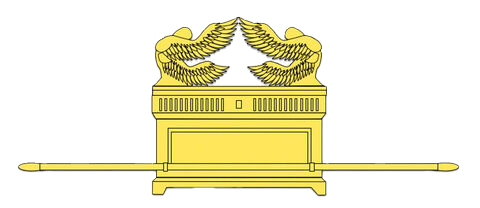
Ark of the Covenant (Most Holy Place)
And thou shalt put the mercy seat above upon the ark; and in the ark thou shalt put the testimony that I shall give thee. And there I will meet with thee, and I will commune with thee from above the mercy seat, from between the two cherubims which are upon the ark of the testimony, of all things which I will give thee in commandment unto the children of Israel. Exodus 25:21-22
"Beyond the inner veil was the holy of holies, where centered the symbolic service of atonement and intercession, and which formed the connecting link between heaven and earth. In this apartment was the ark, a chest of acacia wood, overlaid within and without with gold, and having a crown of gold about the top. It was made as a depository for the tables of stone, upon which God Himself had inscribed the Ten Commandments. Hence it was called the ark of God's testament, or the ark of the covenant, since the Ten Commandments were the basis of the covenant made between God and Israel." PP 348
The Holy and Most Holy Place
"...and the vail shall divide unto you between the holy place and the most holy." Exodus 26:33
According to Scripture, the inner sanctuary had two internal compartments— The Holy Place, and the Most Holy Place.
The Outer Court
The And thou shalt make the court of the tabernacle… Exodus 27:9 The sanctuary was enclosed in an open space called the court of the tabernacle. This court is where the animals were slain.

The Furniture of the sancturay
Two pieces of furniture existed in the court of the tabernacle: The altar of burnt offering and the laver.

The Laver (Outer Court)
Thou shalt also make a laver of brass, and his foot also of brass, to wash withal: and thou shalt put it between the tabernacle of the congregation and the altar, and thou shalt put water therein. Exodus 30:18
"The laver was placed between the altar and the congregation, that before they came into the presence of God, in the sight of the congregation, they might wash their hands and their feet. What impression was this to make upon the people? It was to show them that every particle of dust must be put away before they could go into the presence of God; for he was so high and holy that unless they did comply with these conditions, death would follow. The Lord requires his ministers to be pure and holy, rightly to represent the principles of truth in their own lives, and by their example to bring others up upon a high level." GW92 162

The Altar of Burnt Offering (Outer Court)
Thou shalt also make a laver of brass, and his foot also of brass, to wash withal: and thou shalt put it between the tabernacle of the congregation and the altar, and thou shalt put water therein. Exodus 30:18

Table of Shewbread (Holy Place)
And thou shalt set upon the table shewbread before me alway. Exodus 25:30
"The showbread was kept ever before the Lord as a perpetual offering. Thus it was a part of the daily sacrifice. It was called showbread, or 'bread of the presence,' because it was ever before the face of the Lord. It was an acknowledgment of man's dependence upon God for both temporal and spiritual food, and that it is received only through the mediation of Christ. God had fed Israel in the wilderness with bread from heaven, and they were still dependent upon His bounty, both for temporal food and spiritual blessings. Both the manna and the showbread pointed to Christ, the living Bread, who is ever in the presence of God for us. He Himself said, 'I am the living Bread which came down from heaven.' John 6:48-51. Frankincense was placed upon the loaves. When the bread was removed every Sabbath, to be replaced by fresh loaves, the frankincense was burned upon the altar as a memorial before God." PP 354

Golden Candlestick (Holy Place)
And thou shalt make a candlestick of pure gold: of beaten work shall the candlestick be made: his shaft, and his branches, his bowls, his knops, and his flowers, shall be of the same. And six branches shall come out of the sides of it; three branches of the candlestick out of the one side, and three branches of the candlestick out of the other side. Exodus 25:31-32
"These sacred apartments had no windows to give light. The candlestick was made of purest gold, and was kept burning night and day, and gave light to both apartments. The light of the lamps upon the candlestick reflected upon the boards plated with gold, at the sides of the building, and upon the sacred furniture, and upon the curtains of beautiful colors with cherubims wrought with threads of gold and silver, which appearance was glorious beyond description." 4aSG 9

Altar of Incense (Holy Place)
And thou shalt make an altar to burn incense upon: of shittim wood shalt thou make it. Exodus 30:1
And Aaron shall burn thereon sweet incense every morning: when he dresseth the lamps, he shall burn incense upon it. And when Aaron lighteth the lamps at even, he shall burn incense upon it, a perpetual incense before the LORD throughout your generations. Exodus 30:7-8
"Just before the veil separating the holy place from the most holy and the immediate presence of God, stood the golden altar of incense. Upon this altar the priest was to burn incense every morning and evening; its horns were touched with the blood of the sin offering, and it was sprinkled with blood upon the great Day of Atonement. The fire upon this altar was kindled by God Himself and was sacredly cherished. Day and night the holy incense diffused its fragrance throughout the sacred apartments, and without, far around the tabernacle." PP 348

Ark of the Covenant (Most Holy Place)
And thou shalt put the mercy seat above upon the ark; and in the ark thou shalt put the testimony that I shall give thee. And there I will meet with thee, and I will commune with thee from above the mercy seat, from between the two cherubims which are upon the ark of the testimony, of all things which I will give thee in commandment unto the children of Israel. Exodus 25:21-22
"Beyond the inner veil was the holy of holies, where centered the symbolic service of atonement and intercession, and which formed the connecting link between heaven and earth. In this apartment was the ark, a chest of acacia wood, overlaid within and without with gold, and having a crown of gold about the top. It was made as a depository for the tables of stone, upon which God Himself had inscribed the Ten Commandments. Hence it was called the ark of God's testament, or the ark of the covenant, since the Ten Commandments were the basis of the covenant made between God and Israel." PP 348

The Furniture of the sancturay
Two pieces of furniture existed in the court of the tabernacle: The altar of burnt offering and the laver.
The Laver (Outer Court)

Thou shalt also make a laver of brass, and his foot also of brass, to wash withal: and thou shalt put it between the tabernacle of the congregation and the altar, and thou shalt put water therein. Exodus 30:18
"The laver was placed between the altar and the congregation, that before they came into the presence of God, in the sight of the congregation, they might wash their hands and their feet. What impression was this to make upon the people? It was to show them that every particle of dust must be put away before they could go into the presence of God; for he was so high and holy that unless they did comply with these conditions, death would follow. The Lord requires his ministers to be pure and holy, rightly to represent the principles of truth in their own lives, and by their example to bring others up upon a high level."
The Altar of Burnt Offering (Outer Court)

Thou shalt also make a laver of brass, and his foot also of brass, to wash withal: and thou shalt put it between the tabernacle of the congregation and the altar, and thou shalt put water therein. Exodus 30:18
"In the court, and nearest the entrance, stood the brazen altar of burnt offering. Upon this altar were consumed all the sacrifices made by fire unto the Lord, and its horns were sprinkled with the atoning blood. PP 347
Table of Shewbread (Holy Place)

And thou shalt set upon the table shewbread before me alway. Exodus 25:30
"The showbread was kept ever before the Lord as a perpetual offering. Thus it was a part of the daily sacrifice. It was called showbread, or 'bread of the presence,' because it was ever before the face of the Lord. It was an acknowledgment of man's dependence upon God for both temporal and spiritual food, and that it is received only through the mediation of Christ. God had fed Israel in the wilderness with bread from heaven, and they were still dependent upon His bounty, both for temporal food and spiritual blessings. Both the manna and the showbread pointed to Christ, the living Bread, who is ever in the presence of God for us. He Himself said, 'I am the living Bread which came down from heaven.' John 6:48-51. Frankincense was placed upon the loaves. When the bread was removed every Sabbath, to be replaced by fresh loaves, the frankincense was burned upon the altar as a memorial before God. PP 354
Golden Candlestick (Holy Place)

And thou shalt make a candlestick of pure gold: of beaten work shall the candlestick be made: his shaft, and his branches, his bowls, his knops, and his flowers, shall be of the same. And six branches shall come out of the sides of it; three branches of the candlestick out of the one side, and three branches of the candlestick out of the other side. Exodus 25:31-32
"These sacred apartments had no windows to give light. The candlestick was made of purest gold, and was kept burning night and day, and gave light to both apartments. The light of the lamps upon the candlestick reflected upon the boards plated with gold, at the sides of the building, and upon the sacred furniture, and upon the curtains of beautiful colors with cherubims wrought with threads of gold and silver, which appearance was glorious beyond description." 4aSG 9
Altar of Incense (Holy Place)

And thou shalt make an altar to burn incense upon: of shittim wood shalt thou make it. Exodus 30:1
And Aaron shall burn thereon sweet incense every morning: when he dresseth the lamps, he shall burn incense upon it. And when Aaron lighteth the lamps at even, he shall burn incense upon it, a perpetual incense before the LORD throughout your generations. Exodus 30:7-8
"Just before the veil separating the holy place from the most holy and the immediate presence of God, stood the golden altar of incense. Upon this altar the priest was to burn incense every morning and evening; its horns were touched with the blood of the sin offering, and it was sprinkled with blood upon the great Day of Atonement. The fire upon this altar was kindled by God Himself and was sacredly cherished. Day and night the holy incense diffused its fragrance throughout the sacred apartments, and without, far around the tabernacle.
PP 348
Ark of the Covenant (Most Holy Place)

And thou shalt put the mercy seat above upon the ark; and in the ark thou shalt put the testimony that I shall give thee. And there I will meet with thee, and I will commune with thee from above the mercy seat, from between the two cherubims which are upon the ark of the testimony, of all things which I will give thee in commandment unto the children of Israel. Exodus 25:21-22
"Beyond the inner veil was the holy of holies, where centered the symbolic service of atonement and intercession, and which formed the connecting link between heaven and earth. In this apartment was the ark, a chest of acacia wood, overlaid within and without with gold, and having a crown of gold about the top. It was made as a depository for the tables of stone, upon which God Himself had inscribed the Ten Commandments. Hence it was called the ark of God's testament, or the ark of the covenant, since the Ten Commandments were the basis of the covenant made between God and Israel. PP 348